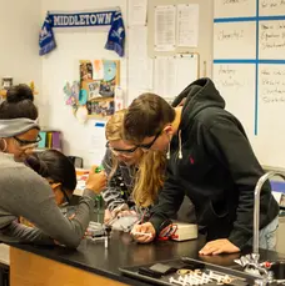Pathway Overview

Pathway Courses
03051(H)
1 Credit
This course uses inquiry-based investigations to explore the relationships within cellular energy systems, cellular structure and function, DNA and genetic influence, evolutionary theory and ecological connections. Students will get experience gathering information to communicate reasoning through formal lab reports and writing to explain systems and models investigated.
0305312 (H)
1 Credit
This course is designed for those interested in the medical field. The course first introduces anatomy and physiology as well as basic terminology and tissues. An overview of chemistry and biology as it relates to the levels of organization is also covered. Next, the course covers the integumentary, skeletal, muscular, and nervous systems; both their structure and function as well as contribution to homeostasis are part of this course. Throughout the course, the students will analyze and collaborate to design a course of action for various case studies. Dissection is required.
*Prerequisite: Biology I
03214
1 Credit
Forensic Science is designed to incorporate the scientific concepts and techniques utilized in the field of forensics. Course units include observational skills, crime scene analysis, evidence gathering and processing, hair, fiber and textile analysis, DNA profiling, fingerprint analysis, blood spatter and forensic anthropology. The course concludes with a death scene investigation that allows students to embody the role of a forensic investigator and ultimately put the skills learned throughout the course into cumulative practice. Evidence-based reasoning is a cornerstone of the course and will be employed using an activity-based approach to frame each curricular unit.
*Prerequisite: Biology I, Chemistry I, Geometry Prerequisite OR concurrent course: Anatomy and Physiology I
03215
1 Credit
Forensic Science II is designed to incorporate the scientific concepts and techniques utilized in the field of forensics. Course units include crime scene analysis, physical/biological evidence gathering and processing, firearms/explosives, toxicology, and communication analysis. The course concludes with a death scene investigation that allows students to embody the role of a forensic investigator and ultimately put the skills learned throughout the course into cumulative practice. Evidence-based reasoning is a cornerstone of the course and will be employed using an activity-based approach to frame each curricular unit. Capturing evidence via photographic or video-graphic means is an essential component of crime scene investigation. As such, students will be required to photo and/or videotape themselves and each other for various assignments and assessments in this course.
*Prerequisite: Forensic Science I